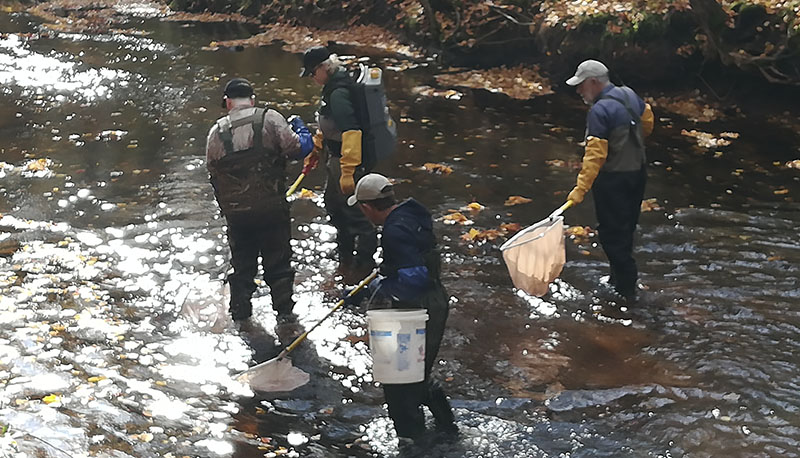Featured Projects
Roseville/Miminegash Watersheds Inc. / Prince Edward Island / 2024
Miminegash River’s Atlantic Salmon Conservation Project

The Miminegash watershed had been a good producer of salmon for many years. However, between the impacts of overfishing and blockages in the river caused by an expanding beaver population, the numbers dropped off throughout the 1970s.
“The beaver blockages went eight and ten miles upstream, and as you know, on Prince Edward Island, if you’re 10 miles upstream, you don’t have a lot of watershed left,” said John Rix, vice-president and longtime committee member of Roseville/Miminegash Watersheds Inc. (RMWI). “So the salmon just disappeared. For a few years, we’d see the odd salmon parr, but there were perhaps eight or ten years where we saw nothing.”
In the early 2000s, a graduate research project found no salmon in the watershed whatsoever. However, through many years of efforts – including stream enhancements, trapping beavers and removing dams and other obstructions – salmon started slowly returning to the waterbody.
“In 2018 local trout fishermen started to catch the odd parr,” said Coordinator Danny Murphy. “Some of us didn’t even know what they were.”
Murphy says that as salmon numbers started to rebound in the river – “we’re not sure we brought them back with all the stream enhancement, but we’re going to take credit for it,” said Murphy with a laugh – a professor from the University of PEI suggested that the river be assessed, to identify the extent of suitable habitat for salmon and what limiting factors needed to be addressed. To carry out that assessment, the RMWI received $13,672 from the Foundation for Conservation of Atlantic Salmon.
“At this point, we’re working up into those systems where we never could get before, the secondary streams,” said Murphy. “We have 12 data loggers and depth loggers and we’re doing that with people from the Department of Forestry, Fish & Wildlife. We’re trying to figure out how quickly it’s going to rebound.”
The assessments will also include monitoring where flow and temperature changes occur in the river. Murphy says that the full assessment will take three years and will involve coordination and cooperation between the RMWI and provincial and non-government ecologists, biologists and technicians.
When the assessment is completed, the RMWI will use the information gleaned from the assessment to develop a new Watershed Management Plan.
“We hope to, someday if we live long enough, to see a salmon fishery again that would be monitored very closely, that wouldn’t result in what it has in the past,” said Murphy.
“If we could get to the point where we even have a catch-and-release fishery here on the west/south side of the island, that would be a great improvement to what we have at this moment,” added Rix.
